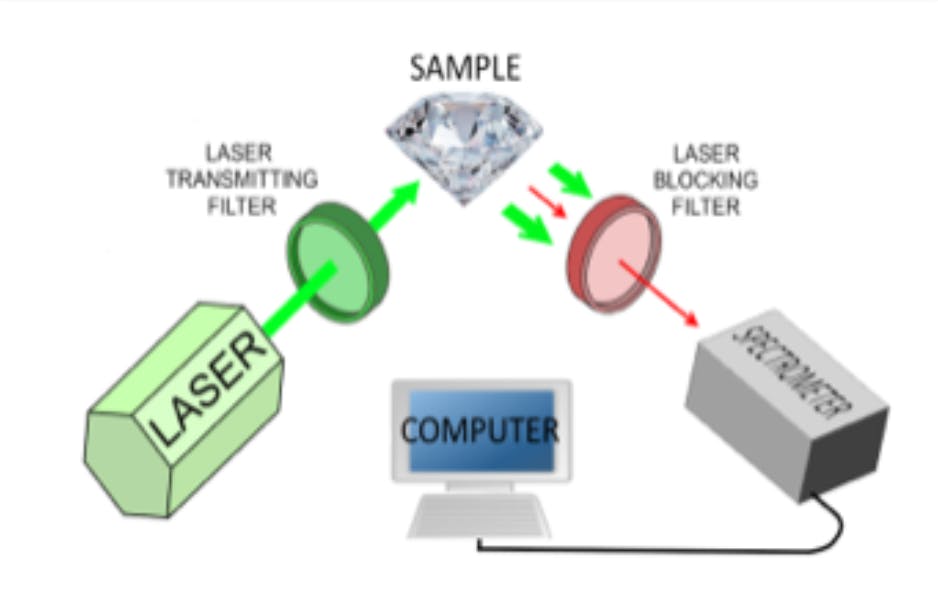Spectroscopy plays a pivotal role in understanding the chemical and physical properties of materials. Two widely used spectroscopic techniques are Raman spectroscopy and Fourier Transform Infrared (FTIR) spectroscopy. While both techniques provide valuable insights into molecular structure and composition, they differ in several aspects. In this article, we will delve into the working principles, advantages, and limitations of Raman and FTIR spectroscopy, as well as explore their complementary nature.
Raman Spectroscopy: Unveiling Vibrational Energy
Raman spectroscopy is based on the inelastic scattering of light, also known as the Raman effect. When a sample is illuminated with monochromatic light, most of the scattered photons undergo elastic scattering (Rayleigh scattering), which does not provide significant information about the sample - which has the same wavelength as the incident laser. However, a small fraction of photons interact with the sample molecules, causing a shift in their energy levels. This energy shift is directly related to the vibrational and rotational modes of the molecules.

Figure 1: Schematic of modern Raman spectroscopy set-up [1]
Raman-active vibrations involve a change in the polarizability of the molecule during the vibration, resulting in the scattered photons having different energy (frequency) than the incident light. The Raman spectrum displays peaks corresponding to these energy shifts, providing information about the molecular bonds, functional groups, and crystal structures present in the sample. Raman spectroscopy is highly sensitive to the chemical composition, even in complex mixtures.
Pros of Raman Spectroscopy:
Non-destructive: Raman spectroscopy requires minimal sample preparation, making it a non-destructive technique suitable for analyzing delicate samples or valuable artifacts.
Spatially resolved analysis: Raman spectroscopy can be combined with imaging techniques, allowing for the spatial mapping of chemical composition within a sample. This capability is particularly useful for studying heterogeneous samples, such as biological tissues or geological specimens.
Molecular fingerprinting: Each compound has a unique Raman fingerprint, enabling the identification and characterization of unknown substances. Raman spectroscopy can be used for qualitative and quantitative analysis in a wide range of applications, including pharmaceuticals, forensics, and materials science.
Cons of Raman Spectroscopy:
Fluorescence interference: Some samples exhibit fluorescence when excited by the laser light used in Raman spectroscopy. The fluorescence signal can overshadow the Raman signal, making it difficult to obtain accurate spectra. This issue can be mitigated by using appropriate laser wavelengths and implementing advanced data processing techniques.
Limited penetration depth: Raman spectroscopy has a limited penetration depth, typically in the range of a few micrometers to tens of micrometers. It is not suitable for analyzing samples with significant thickness or those that are optically opaque.
FTIR Spectroscopy: Probing Molecular Vibrations
Fourier Transform Infrared (FTIR) spectroscopy, on the other hand, relies on the absorption of infrared radiation by molecules. The infrared region of the electromagnetic spectrum corresponds to the vibrational energy levels of molecular bonds. When infrared light passes through a sample, some of the photons are absorbed by the sample molecules, resulting in characteristic absorption bands.

Figure 2: Schematic diagram showing the working principle of an interferometer.[2]
The FTIR technique measures the intensity of absorbed light at different wavelengths, generating a spectrum that represents the molecular vibrational modes and functional groups present in the sample. The positions and shapes of the absorption bands provide information about chemical bonding, molecular structure, and the presence of specific functional groups.
Pros of FTIR Spectroscopy:
Broad applicability: FTIR spectroscopy is widely used in various fields, including pharmaceuticals, polymers, environmental analysis, and food science. It can analyze both organic and inorganic compounds, making it a versatile technique for material characterization.
Quantitative analysis: FTIR spectroscopy allows for quantitative analysis of components within a sample. By measuring the intensity of absorption bands, it is possible to determine the concentration of specific compounds.
High signal-to-noise ratio: FTIR spectroscopy typically exhibits a high signal-to-noise ratio, enabling the detection of weak absorption bands. This attribute is particularly advantageous when analyzing samples with low concentrations or complex mixtures.
Cons of FTIR Spectroscopy:
Sample preparation: In some cases, sample preparation for FTIR spectroscopy can be more involved compared to Raman spectroscopy. The sample must be in the form of a thin film or a transparent pellet to allow for efficient transmission of the infrared light.
Solvent interference: FTIR spectroscopy is sensitive to solvents that absorb in the same wavelength range as the sample. This interference can complicate the analysis of samples dissolved in solvents, requiring careful solvent selection or additional techniques to overcome the issue.
Complementary Nature of Raman and FTIR Spectroscopy

Figure 3: A film of polyethylene terephthlate (PET) was analysed with simultaneous O-PTIR and Raman. The spectra were acquired from the same spatially resolved, sub-micron spot. IR and Raman from PET film [3]
Raman and FTIR spectroscopy are highly complementary techniques, offering distinct advantages that make them valuable tools in analytical science. While Raman spectroscopy excels in the identification of compounds and provides detailed information about molecular structures, FTIR spectroscopy is particularly useful for quantification and broad-range analysis of functional groups. Their combined application enables comprehensive material characterization, allowing researchers to gain a deeper understanding of complex samples.
Moreover, Raman and FTIR spectroscopy can be used in tandem to overcome certain limitations of each technique. For example, when a sample exhibits fluorescence interference during Raman analysis, FTIR can be employed as an alternative. Conversely, if FTIR cannot penetrate through a thick or opaque sample, Raman spectroscopy can provide valuable surface information.
Conclusion
Raman and FTIR spectroscopy are powerful techniques for investigating the molecular composition and structure of various materials. While Raman spectroscopy offers non-destructive analysis, spatial resolution, and molecular fingerprinting, FTIR spectroscopy provides broad applicability, quantitative analysis, and high signal-to-noise ratio. Their complementary nature allows researchers to leverage the strengths of each technique, enabling a comprehensive understanding of complex samples. By harnessing the capabilities of Raman and FTIR spectroscopy, scientists can continue to unlock valuable insights across a wide range of scientific disciplines.
